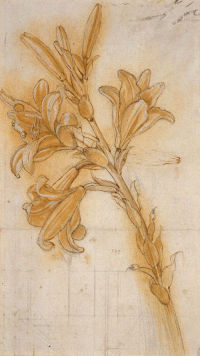Remaking Nature Click on the thumbnails to explore the trail
Read more about this trail (expand)
Leonardo’s ultimate aim was to imitate nature by remaking nature, as opposed to slavishly copying natural forms. This would require a profound understanding of the relationship between the effects of natural appearances and the underlying causes that gave rise to their form. Equipped with this knowledge, Leonardo believed he could create forms equitable to those found in nature, many of which might be of great service to man.

- Enlarge
- Zoom & explore
- The Royal Collection © 2005, Her Majesty Queen Elizabeth II
Study of a lily c1480-85
This drawing may be the sole survivor of the early “studies of flowers copied from nature” recorded in a list of works taken by Leonardo from Florence to Milan.
The buds, blossoms, stamens and pistils of the Lilium candidum are all accurately represented. Not only has the appearance of the flower been captured, but also its growth patterns from buds to blossoms, which branch out from the stem just as they do in nature. Sepia washes have been applied to the drawing to model the forms of the plant in three-dimensions.
Such botanical accuracy is not a feature of Leonardo’s paintings where plants are suggested rather than described in detail. Apelles when painting a field was said to have visually described every blade of grass. In Leonardo’s paintings, detailed observation of individual forms yields to a more convincing impression of the whole.
For Leonardo, the drawing was primarily a learning exercise. The lily is pricked for transfer but has not been copied in the Annunciation. There the flower has been reinterpreted, its scale and angle altered. Only the pattern of growth is the same.
In Leonardo's words
Though human genius in its various inventions with various instruments may answer the same end, it will never find an invention more beautiful or more simple or direct than nature, because in her inventions nothing is lacking and nothing is superfluous.
This drawing of a lily copied from nature is similar but not identical to the lily held by the Angel in the Annunciation, Galleria degli Uffizi. Having first drawn the flower with a soft black chalk, Leonardo then re-enforced the lines with pen and ink and added a coloured wash to convey the smooth shiny surface of the petals, leaves and stems. Although this study was not used for the Annunciation, it may well have been used in another version.
The outlines have been pricked through with a metal point, which suggests a method of direct transfer that involved pouncing the pricked lines with a small bag of charcoal dust in order to produce a sort of “join the dots” outline on the prepared panel, which the artist could then follow in his painting.
- Medium Pen and ink over black chalk with wash
- Size 31.4 x 17.7 cm
- Location The Royal Collection











